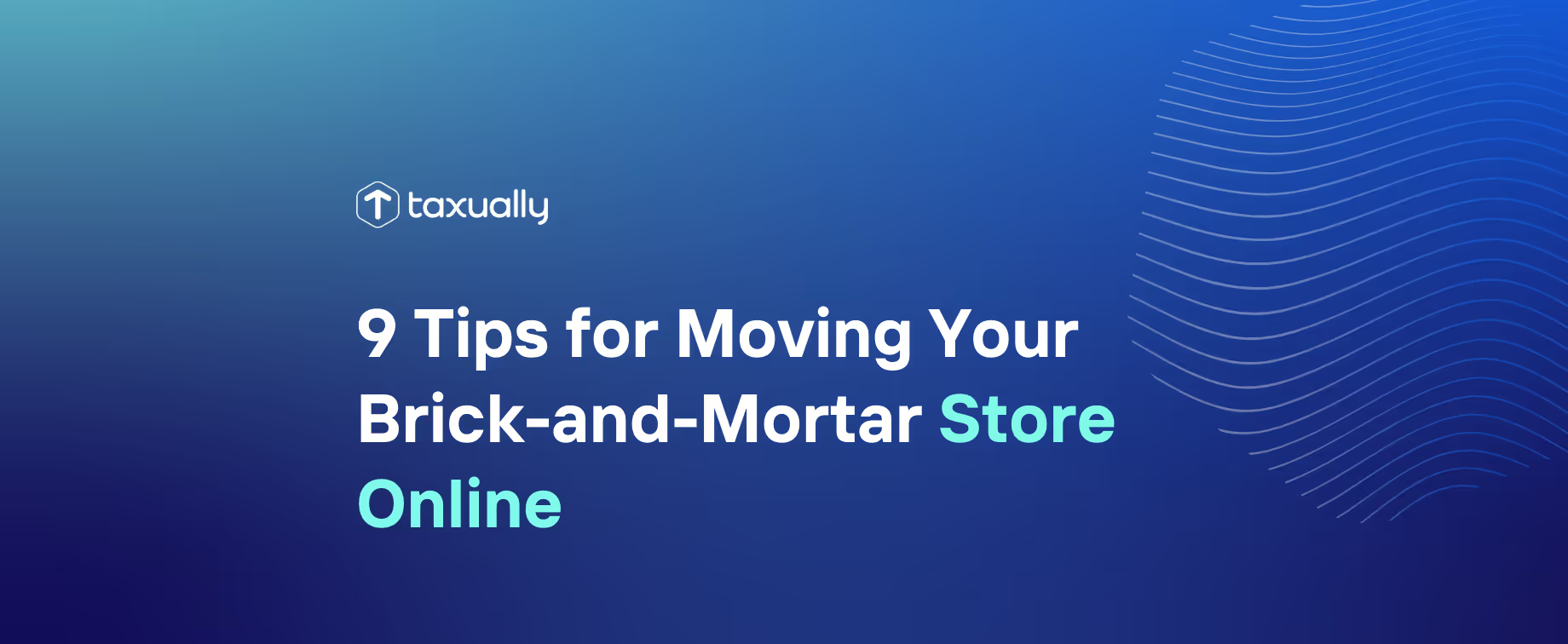Key takeaways
- Expand your reach and sales potential: Moving online lets your business reach customers nationwide or globally—24/7
- Choose the right tools and design: A strong e-commerce platform, SEO optimization, and mobile-friendly design are key to online success.
- Focus on experience and adaptability: Great visuals, smooth checkout, and responsive customer support help drive loyalty and long-term growth.
In today's digital age, selling online is not just an option—it's essential for the growth and sustainability of your business. If you've been successfully running a brick-and-mortar store, expanding into online retail can open up new avenues for reaching customers beyond your local area. Whether you're looking to create an online store from scratch or optimize your existing online selling efforts, here are nine tips to guide you through the transition.
The benefits of creating an online store
Transitioning from a brick-and-mortar store to an online retail presence offers numerous advantages that can significantly enhance your business. Here are some key benefits of moving your store online:
Reach a broader audience
One of the most significant benefits of creating an online store is the ability to reach customers beyond your local area. With an online retail shop, you can attract customers from across the country or even globally, vastly expanding your potential market. This increased reach can lead to higher sales and brand recognition.
Lower operational costs
Operating an online store typically involves lower overhead costs compared to a physical store. You can save on expenses like rent, utilities, and in-store staff. Additionally, many online selling platforms offer affordable options for hosting and maintaining your website, making it easier to manage your budget.
24/7 Availability
An online store never closes, meaning customers can shop at any time of day or night. This round-the-clock availability can lead to more sales opportunities and greater convenience for your customers, who can browse and purchase products whenever it suits them.
Enhanced customer data and insights
Selling online gives you access to valuable data about your customers and their shopping behaviors. You can track metrics such as website traffic, conversion rates, and customer demographics. This data allows you to make informed decisions about marketing strategies, product offerings, and customer service improvements.

Scalability
An online store is easier to scale than a brick-and-mortar location. As your business grows, you can add new products, reach new markets, and expand your inventory without the need for additional physical space. E-commerce platforms offer tools and integrations that can help manage increased traffic and sales seamlessly.
Increased flexibility
Operating an online retail shop provides you with the flexibility to adapt quickly to market trends, customer preferences, and seasonal demands. You can easily update your website with new products, promotions, or information, allowing you to stay competitive and responsive to the needs of your customers.
Better inventory management
E-commerce platforms often include inventory management tools that help you keep track of stock levels, manage orders, and streamline fulfillment processes. This can reduce the risk of overstocking or running out of popular items, leading to a more efficient and profitable business.
Enhanced customer experience
Moving your store online allows you to offer a more personalized shopping experience. You can use customer data to recommend products, provide tailored discounts, and create loyalty programs that encourage repeat purchases. Additionally, offering convenient features like wish lists, customer reviews, and multiple payment options can enhance the overall shopping experience.
How to set up an online store that’s a success
Transitioning your brick-and-mortar store to an online retail shop can open up new opportunities for growth and sales. However, it's important to approach this shift strategically. From understanding your online audience to optimizing your site for search engines, there are key steps that can make your move into online selling successful.
1. Understand your online audience
Before you set up your online store, it's crucial to understand who your online customers are. While your physical store may attract a specific demographic, the online retail space opens you up to a broader, more diverse audience. Conduct market research to identify your target market's preferences, purchasing behaviors, and online shopping habits. This knowledge will help you tailor your online retail shop to meet their needs and improve your chances of success.
2. Choose the right e-commerce platform
Selecting the right platform is fundamental to creating an online store. Popular platforms like Shopify, WooCommerce, and BigCommerce offer various features and integrations that can help you set up an online store efficiently. Consider factors like ease of use, customization options, payment gateways, and scalability when choosing a platform. Ensure that the platform you choose can grow with your business and handle increased traffic and sales over time.
3. Optimize your website for SEO
Search engine optimization (SEO) is vital for driving traffic to your online retail store. Use relevant keywords throughout your website to improve your search engine rankings. Optimize your product descriptions, meta tags, and alt text for images, and create quality content like blogs or guides that address common customer queries. A well-optimized site will help your online retail shop appear higher in search results, attracting more potential customers.
4. Provide high-quality product images and descriptions
Online shoppers rely on images and descriptions to make purchasing decisions, so it's essential to present your products in the best possible light. Invest in high-quality product photography that showcases your products from multiple angles. Write detailed, accurate product descriptions that highlight the features, benefits, and specifications of each item. This will not only help in selling online but also reduce the likelihood of returns and dissatisfied customers.
5. Offer multiple payment options
When creating an online store, it's important to offer a variety of payment methods to accommodate different customer preferences. Ensure your online retail shop supports credit cards, debit cards, PayPal, and other popular payment gateways. If you plan to sell online internationally, consider offering region-specific payment options and ensuring your store supports multiple currencies. A seamless and secure payment process will build trust and encourage more sales.

6. Implement a user-friendly design
The design of your online retail store plays a crucial role in the user experience. A clean, intuitive layout that makes it easy for customers to find what they're looking for can significantly impact your online selling success. Ensure your website is mobile-friendly, as more consumers are shopping from their smartphones. Simplify the navigation, make the checkout process straightforward, and use clear calls to action to guide customers toward making a purchase.
7. Leverage social media for marketing
Social media platforms are powerful tools for driving traffic to your online retail shop. Use platforms like Instagram, Facebook, and Pinterest to showcase your products, share customer testimonials, and run promotions. Engaging with your audience on social media helps build a loyal customer base and increases brand awareness. Additionally, you can utilize social media advertising to target specific demographics and increase your reach.
8. Provide excellent customer support
Customer support is just as important online as it is in a brick-and-mortar store. Offer multiple channels for customers to reach you, such as email, live chat, and phone support. Ensure that your support team is well-trained to handle online inquiries and that they can assist with everything from product questions to returns. Providing excellent customer service will foster trust and loyalty, encouraging repeat business in your online retail shop.
9. Analyze and adapt
Once your online store is up and running, continuously analyze its performance. Use tools like Google Analytics to track visitor behavior, sales data, and other key metrics. Pay attention to what products are selling well, where your traffic is coming from, and how customers are interacting with your site. Use this data to make informed decisions and adapt your strategies to improve your online selling performance over time.
Conclusion
Moving your brick-and-mortar store online is a significant step that can bring exciting opportunities for business growth. By following these tips, you can create an online shop that complements your physical store and reaches a wider audience. Remember, success in online retail requires ongoing effort, adaptation, and a commitment to providing an excellent customer experience. Start your journey into the world of online retail with confidence, and watch your business flourish in the digital marketplace.
Do you need help with your VAT or sales tax compliance? Book a free call with one of our tax experts to find bespoke solutions for your business, optimize your tax costs, and reach millions of new potential customers.
Frequently asked questions
New Year's Day - 1/1/2024Memorial Day - 5/27/20244th of July - 7/4/2024Labor Day - 9/2/2024Thanksgiving Day - 11/28/2024Day after Thanksgiving - 11/29/2024Christmas Eve - 12/24/2024Christmas Day - 12/25/2024
Why should I move my physical store online?
Selling online allows you to reach a wider audience, reduce operating costs, and generate sales 24/7—without the limits of location or opening hours.
What’s the first step in creating an online store?
Start by understanding your online audience and choosing an e-commerce platform like Shopify, WooCommerce, or BigCommerce that suits your business size and goals.
How can I attract customers to my new online shop?
Use SEO to improve visibility, run social media campaigns, and offer great visuals, smooth checkout, and excellent customer support to boost conversions.
How do I make my website user-friendly?
Keep your design clean and mobile-friendly, simplify navigation and checkout, and offer multiple secure payment options to enhance the shopping experience.



















